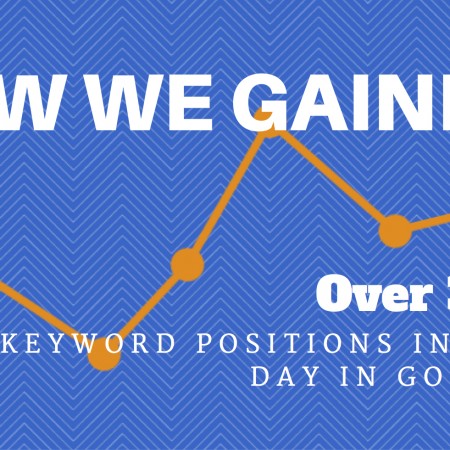Why Keyword Search Volume Doesn’t Matter When You Choose Your Keywords (& What Does Matter)
If I asked for a show of hands to see who researches their keywords by highest search volume, I’d see a pretty unanimous answer. If you’re a true nerd / geek / SEO’er, you might have even had dreams of climbing the search results to #1 by optimizing for those keywords. (Kind of like a new pop artist who hopes to crack the Billboard Top 100 with their first single.) When you pick a keyword, what do you go by? Are you using the best metrics? Every business wants to show up at the top of the SERPs (search engine result pages). But knowing how… that’s a skill that involves, at the core fundamental, knowing how to pick out a great keyword. And not everyone has that skill. Keep reading for an in-depth guide on what matters most when you’re choosing best opportunity, high-ROI keywords. (The answer, surprisingly, is decidedly not keyword search volume.) Keyword Search Volume: The Skinny Everyone wants that coveted top organic #1, #2, or #3 hit in Google. However, what you may not realize is top brands have already cornered those keywords. This includes multi-million-dollar corporations. These are brands you are not going to be able to compete with, especially if you’re a small business. What do those top-ranking keywords look like? Nine times out of 10, they’re broad keywords – short phrases that aren’t specific. For example: “cake,” “baking,” and “baking cakes.” If you’re a small-town baker and you try to rank for these terms, you’ll be out of luck. Instead, you may find yourself competing with the likes of Cooking Light, Food Network, and Epicurious. Let’s face it – you’re never going to win, here. So, what can you do, instead? What’s the smarter strategy? For good results for your particular business, you don’t need high traffic from high search volume keywords. Instead, you need the right traffic. Forget Search Volume – Get the Right Traffic with High-Converting Keywords Throw search volume out the window for now. Yes, it was once the be-all, end-all of keywords, but nothing in this world is static, right? I’m not saying search volume is completely irrelevant. But, I am urging you to look at other avenues for driving people to your site. Let’s start by defining what we mean when we talk about the “right” traffic. You’ll have an easier time converting customers if they’re in an ideal state of the buying process. This is the “right” traffic – the people who are looking for you, but don’t yet realize you exist. If they knew you existed, they would be ready to jump on board and fish for their wallets. Broad keywords do not drive this kind of traffic to your site. What will? Long tail keywords! Long tail Keywords: Specificity and Relevancy for Search Long tail keywords are just that: longer, more specific, and relevant to the customer’s needs. For instance, a person who needs a specific type of cake will not search for “cake.” Instead, they might search for “wedding cake chocolate swirl Rhode Island.” Or, “birthday cake yellow with sprinkles.” A search string that is becoming even more common might look like this: “Where can I get a yellow birthday cake with chocolate frosting in Rhode Island?” All of these have a few things in common, though they vary in subject matter. The people searching know what type of cake they want and where they want to get it. If you’re a baker and you optimize your site for long tail keywords like this, you’ll strike gold. Why? Because long tail keywords have less competition than their broad counterparts. You have a far better chance of ranking for “wedding cake chocolate swirl Rhode Island” than “cake.” Plus, customers use long tail keywords like this when they have a higher buying intent. They know what they’re looking for, what they need, or what they want. If you have it, there’s a very good chance you’ll close the deal. Basically, these keywords fall right into your sweet spot for driving traffic. Take a look at the brands who have successfully ranked for the above long tail keyword example. There’s only one multi-million-dollar corporation on this list (Ben & Jerry’s). The rest are small bakeries or boutique shops. That’s the power of the long tail keyword in action. How Do You Choose the Right Long Tail Keywords? According to Search Engine Journal (SEJ), one of the keys to driving conversions from search results is to engage people at the perfect time. It’s a two-way street. Their intent needs to match up with the keyword, and the keyword needs to be relative to their intent. This is that sweet spot we mentioned earlier. Hit it, and you’ll see ROI. Here are some other keys for choosing the best long tail keywords for you. They have to do with relevancy and uniqueness. 1. Relevancy, Relevancy, Relevancy When a keyword is relevant to you, it ties back to your particular brand. This includes what you do, who you are, where you’re located, or what you sell. The relevance of your keywords is the brunt of what makes long tail types work. If you’re not using relevant long tails, you won’t be taking advantage of their conversion power. 2. Use What Makes You Stand Out (Your Differentiation Factor) A highly unique keyword could net you a buyer every time someone searches for it. Wow! That’s a BIG deal. At the same time, that particular keyword could have next to no search volume because of its uniqueness. Fact: this is common for keywords with good opportunities. In other words, it’s not a problem because the conversion value is so high. The more unique your keyword, the more you’re targeting a specific buyer – the one looking to pull the trigger and make the purchase! These types of keywords don’t work well for everyone – but they work great for you. The opportunity is personal, and that’s a big bonus. Why Broad, Short Tail Keywords Are on the Way Out Short tail … Read more


